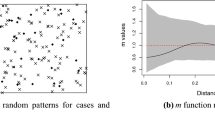Abstract
Regional scientists have adopted two rather different empirical views of agglomeration. One view, favored by economists, examines the distribution of some property across a class of entities (agents, regions). The other view, favored by geographers, examines the spatial correlation of that property based on the arrangement of those entities. Adopting the first approach, this paper develops new statistical properties for the Herfindahl–Hirschman concentration index. The methodology is based on the standard occupancy problem in physics, where r particles (points) are distributed across n cells (quadrats). Both r and n are random variables so the Herfindahl index itself is considered a random variable H(r, n). Including all the equi-probable states of this random variable, expected values for both the mean and standard deviation are specified. A test compares the Herfindahl score for a specific state (sample) to the score based on all possible states, allowing inferences to be made about whether the observed score conforms to a random process. A few applications follow and then a short discussion concludes the chapter.
Access this chapter
Tax calculation will be finalised at checkout
Purchases are for personal use only
Similar content being viewed by others
References
Atkinson A (2015) Inequality. Harvard University Press, Cambridge
Batty M (2013) The new science of cities. MIT Press, Cambridge
Boots B, Getis A (1988) Point pattern analysis. Sage, Beverly Hills
Carlton D, Perloff J (1990) Modern industrial organization. Harper Collins, New York
Cliff A, Ord K (1973) Spatial autocorrelation. Pion, London
Cliff A, Ord K (1981) Spatial processes: models and applications. Pion, London
Feller W (1957) An introduction to probability theory and its applications, vol 1, 2nd edn. Wiley, New York
Getis A (2008) A history of the concept of spatial autocorrelation: a geographer’s perspective. Geogr Anal 40:297–309
Getis A, Ord K (1992) The analysis of spatial association by use of distance statistics. Geogr Anal 24:189–206
Hirschman A (1964) The paternity of an index. Am Econ Rev 54:761
Isard W (1960) Methods of regional analysis. MIT Press, Cambridge
Milanovic B (2016) Global inequality. Harvard University Press, Cambridge
Mulligan G (2018) Patent generation in U.S. metropolitan areas. In: Bernhard I (ed) Diversity, innovation, entrepreneurship: regional, urban, national and international perspectives. University West, Trollhättan, pp 299–314
Mulligan G, Carruthers J (2021) City-size distribution: the evolution of theory, evidence, and policy in regional science. In: Fischer M, Nijkamp P (eds) The handbook of regional science, 2nd edn. Springer, Berlin, pp 41–59
Mulligan G, Schmidt C (2005) A note on localization and specialization. Growth Chang 36:565–576
Parzen I (1960) Modern probability theory and its applications. Wiley, New York
Sakai Y (2018) Liverpool merchants versus Ohmi merchants: how and why they dealt with risk and insurance differently. Asia-Pacific J Reg Sci 2:15–33
Sen A (1997) On economic inequality: expanded edition. Clarendon Paperbacks, Oxford
U.S. Bureau of Labor Statistics (2014) Measuring occupational concentration by industry. Beyond the Numbers (Feb issue) 3:1–13. https://www.bls.gov/opub/btn/volume-3/pdf/measuring-occupational-concentration-by-industry.pdf. Last accessed 4/5/20
U.S. Department of Justice (2010) Horizontal merger guidelines. https://www.justice.gov/sites/default/files/atr/legacy/2010/08/19/hmg-2010.pdf. Last accessed 4/5/20
West G (2017) Scale: the universal laws of life, growth, and death in organisms, cities, and companies. Penguin Books, New York
World Bank (1981) World development Bank 1981. International Bank for Reconstruction and Development, Washington, DC
World Bank (2019) World Development Indicators 2019. https://datatopics.worldbank.org/world-development-indicators/themes/economy.html.pdf. Last accessed 1/3/21
Author information
Authors and Affiliations
Corresponding author
Editor information
Editors and Affiliations
Appendix
Appendix
The formula for integers developed by James Stirling (1692–1770) has been given much attention by many prominent mathematicians, especially since the advances made in research on complex numbers by Abraham de Moivre (1667–1754). The formula provides an approximate solution for integer factorials where the absolute errors diverge, but the relative or proportional errors converge, as the integers become larger in size. In short, the formula is.
where the sign ~ indicates that the ratio of the formula’s two sides approaches unity as the size of the integer n approaches infinity (Feller 1957). Note, when n = 10, the LHS of the formula is 3,628,800, while the RHS is 3,598,695.6, and the approximation generates a relative error of less than 1%. In fact, when n = 8 the error is 1.03%, when n = 10, the error is 0.83%, and when n = 12 the error is 0.63%.
As Parzen (1960) points out this factorial approximation for integers is a special case of the gamma function for real numbers, which continues to play an important role in various aspects of probability theory. This function also can be tied to the Riemann Zeta function, which has key applications to the study of prime numbers in mathematics and string theory in physics. It is worth noting that, in general, the gamma function Γ(n + 1) = n!, where Γ(1) = 1. When addressing increasingly larger integers, Stirling’s formula provides solutions that asymptotically approach the values for the real numbers that are calculated in the various integral solutions of the gamma function.
Rights and permissions
Copyright information
© 2022 The Author(s), under exclusive license to Springer Nature Singapore Pte Ltd.
About this chapter
Cite this chapter
Mulligan, G.F. (2022). A Test for the Herfindahl Index. In: Kawano, M., Kourtit, K., Nijkamp, P., Higano, Y. (eds) Theory and History in Regional Perspective. New Frontiers in Regional Science: Asian Perspectives, vol 56. Springer, Singapore. https://doi.org/10.1007/978-981-16-6695-7_18
Download citation
DOI: https://doi.org/10.1007/978-981-16-6695-7_18
Published:
Publisher Name: Springer, Singapore
Print ISBN: 978-981-16-6694-0
Online ISBN: 978-981-16-6695-7
eBook Packages: Economics and FinanceEconomics and Finance (R0)




